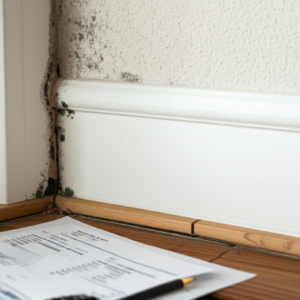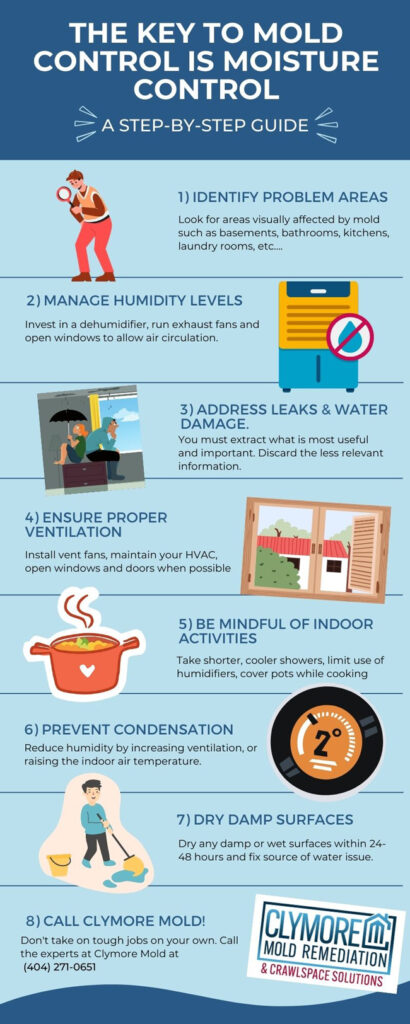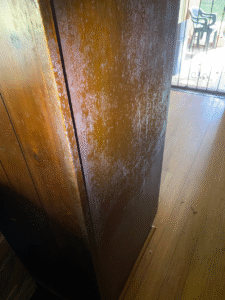
The Hidden Costs of Delaying Mold Removal: A Financial Perspective
Financial Implications of Postponing Mold Remediation Mold infestation is not just a health hazard but also a significant financial concern, particularly when its removal is
Mold can be a real bummer, creeping up in the damp corners of our homes, causing health problems and even damaging our precious belongings. But fret not, because the key to mold control is moisture control. In this article, we’ll dive into the nitty-gritty of why controlling moisture is essential, how you can do it effectively, and arm you with the knowledge you need to keep mold at bay. So, let’s get cracking!
Why Mold Loves Moisture
Mold spores are everywhere, just biding their time, waiting for the perfect conditions to grow. And you guessed it, moisture is their number one friend. When moisture levels are high, mold spores can easily latch onto surfaces and start multiplying, wreaking havoc in your home.
The presence of mold isn’t just unsightly; it can also lead to health issues. Mold exposure can cause:
That’s why it’s crucial to nip mold growth in the bud by controlling moisture.
(download this infographic here.)

(download this infographic here.)
The first step to moisture control is identifying the problem areas in your home. Common culprits include:
Once you’ve pinpointed the problem areas, it’s time to roll up your sleeves and tackle the moisture issue head-on.
Aim to maintain a relative humidity level of 30-50% in your home. You can do this by:
Quickly repair any leaks or water damage in your home to prevent mold growth. Be proactive in checking for leaks, especially after heavy rainfall or snow.
Improve ventilation in your home by:
Reduce moisture buildup by being conscious of activities that can generate excess moisture. These include:
Signs of mold growth include musty odors, discolored surfaces, and health symptoms like allergies or respiratory issues.
For small, non-toxic mold problems, you can use a bleach solution to clean the affected area. However, for larger or toxic mold issues, it’s best to call a professional.
The key to mold control is moisture control. By addressing moisture issues in your home and maintaining a relative humidity level of 30-50%, you can prevent mold growth.
In a nutshell, the key to mold control is moisture control. By identifying problem areas, managing humidity levels, addressing leaks and water damage, ensuring proper ventilation, and being mindful of indoor activities, you can effectively keep mold at bay. Remember, a well-ventilated, dry home is your best defense against mold growth. So, make it a priority to maintain a healthy moisture balance in your living space and enjoy a mold-free home.
Armed with the knowledge that the key to mold control is moisture control, you can now tackle any mold-related issues with confidence. Don’t let mold outstay its welcome; show it the door by implementing the strategies outlined in this guide. Stay vigilant, be proactive, and keep your home healthy and mold-free. Or simply get in touch with Clymore Mold Solutions & Crawlspace Remediation today.

Financial Implications of Postponing Mold Remediation Mold infestation is not just a health hazard but also a significant financial concern, particularly when its removal is

When Mark Clymore of Clymore Mold Remediation and Crawlspace Solutions received the call about a residential property in metro Atlanta, he knew immediately this would

Importance of Mold Inspection in Commercial Properties Mold inspection is a crucial aspect of maintaining a healthy, safe, and legally compliant commercial environment. Mold can

Unexplained Musty Odors One of the more perceptible indicators of hidden water damage is the presence of musty odors that persist despite thorough cleaning. Such

The Health Implications of Mold Exposure Mold, a ubiquitous presence in both indoor and outdoor environments, thrives in moist conditions and can infiltrate homes and

The Science of Mold Remediation: Insights from Clymore Mold Remediation and Crawlspace Solutions Mold is a persistent problem that can affect both residential and commercial